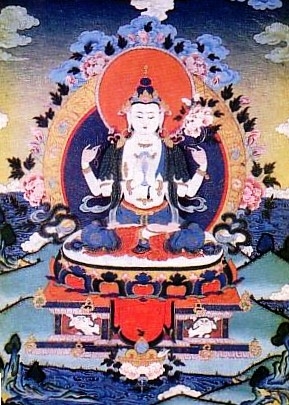Avalokiteshvara: Difference between revisions
Jump to navigation
Jump to search
(→External Links: link to LH incl more recent version of Mipham text) |
|||
| Line 45: | Line 45: | ||
==External Links== | ==External Links== | ||
*[http://www.himalayanart.org/pages/avalokita/index.html Avalokiteshvara outline page at Himalayan Art Resources] | *[http://www.himalayanart.org/pages/avalokita/index.html Avalokiteshvara outline page at Himalayan Art Resources] | ||
*{{LH|topics/avalokiteshvara|Avalokiteśvara Series on Lotsawa House}} | |||
[[Category:Buddhas and Deities]] | [[Category:Buddhas and Deities]] | ||
[[Category:Bodhisattvas]] | [[Category:Bodhisattvas]] | ||
Revision as of 11:32, 26 March 2016

Avalokiteshvara (Skt. Avalokiteśvara; Tib. སྤྱན་རས་གཟིགས་, Chenrezik; Wyl. spyan ras gzigs or spyan ras gzigs dbang phyug) is said to be the essence of the speech of all the buddhas and incarnation of their compassion. As one of the Eight Great Close Sons, he is usually depicted as white in colour and holding a lotus. He is of special importance to Tibetans, so much so that he is sometimes described as the patron deity of Tibet. Among his emanations are King Songtsen Gampo — who is credited with authoring the Mani Kabum, a cycle of teachings and practices dedicated to the deity — as well as the lineages of Dalai Lamas and Karmapas.
Forms
Masculine Forms
One Face and Two Arms
- Lokanatha (Tib. འཇིག་རྟེན་མགོན་པོ་, Wyl. 'jig rten mgon po)
- Khasarpana or Khasarpani
- Padmanarteshvara (Tib. པདྨ་གར་གྱི་དབང་ཕྱུག་, Wyl. padma gar gyi dbang phyug)
- Nilakhanta
- Padmapani
- Simhanada (Tib. སེང་གེ་ང་རོ་, Wyl. seng ge nga ro)
- Tailokyavashamkara
- Vajradharma (Tib. རྡོ་རྗེ་ཆོས་, Wyl. rdo rje chos)
One Face and Four Arms
- Chaturbhuja
- Jinasagara (Tib. རྒྱལ་བ་རྒྱ་མཚོ་, Wyl. rgyal ba rgya mtsho)
- Shadakshrilokeshvara (Tib. སྤྱན་རས་གཟིགས་ཕྱག་བཞི་པ་, Wyl. spyan ras gzigs phyag bzhi pa)
- Rakta Lokeshvara
One Face and Eight Arms
- Amoghapasha (Tib. དོན་ཤགས་, Wyl. don shags)
Three Faces
- Chintachakra
Eleven Faces
- Ekadashamukha (Tib. བཅུ་གཅིག་ཞལ་, Wyl. bcu gcig zhal)
- Sahasrabhujalokeshvara (Tib. ཕྱག་སྟོང་ཞལ་བཅུ་གཅིག་, Wyl. phyag stong zhal bcu gcig)
- Vajragarbha
Feminine Forms
- Guanyin (Chinese)/Kannon(Japanese)
Further Reading
- Bokar Rinpoche, Chenrezig, the Lord of Love (San Francisco: Clearpoint Press, 1991)
- Jamgön Mipham, A Garland of Jewels, trans. by Lama Yeshe Gyamtso (Woodstock: KTD Publications, 2008)
- John Blofeld, Bodhisattva of Compassion—The Mystical Tradition of Kuan Yin (Boston: Shambhala, 1988)
- Tulku Thondup, The Healing Power of the Mind (Boston: Shambhala, 1998), 'Invoking the Buddha of Compassion to Open Our Hearts' in chapter 15.